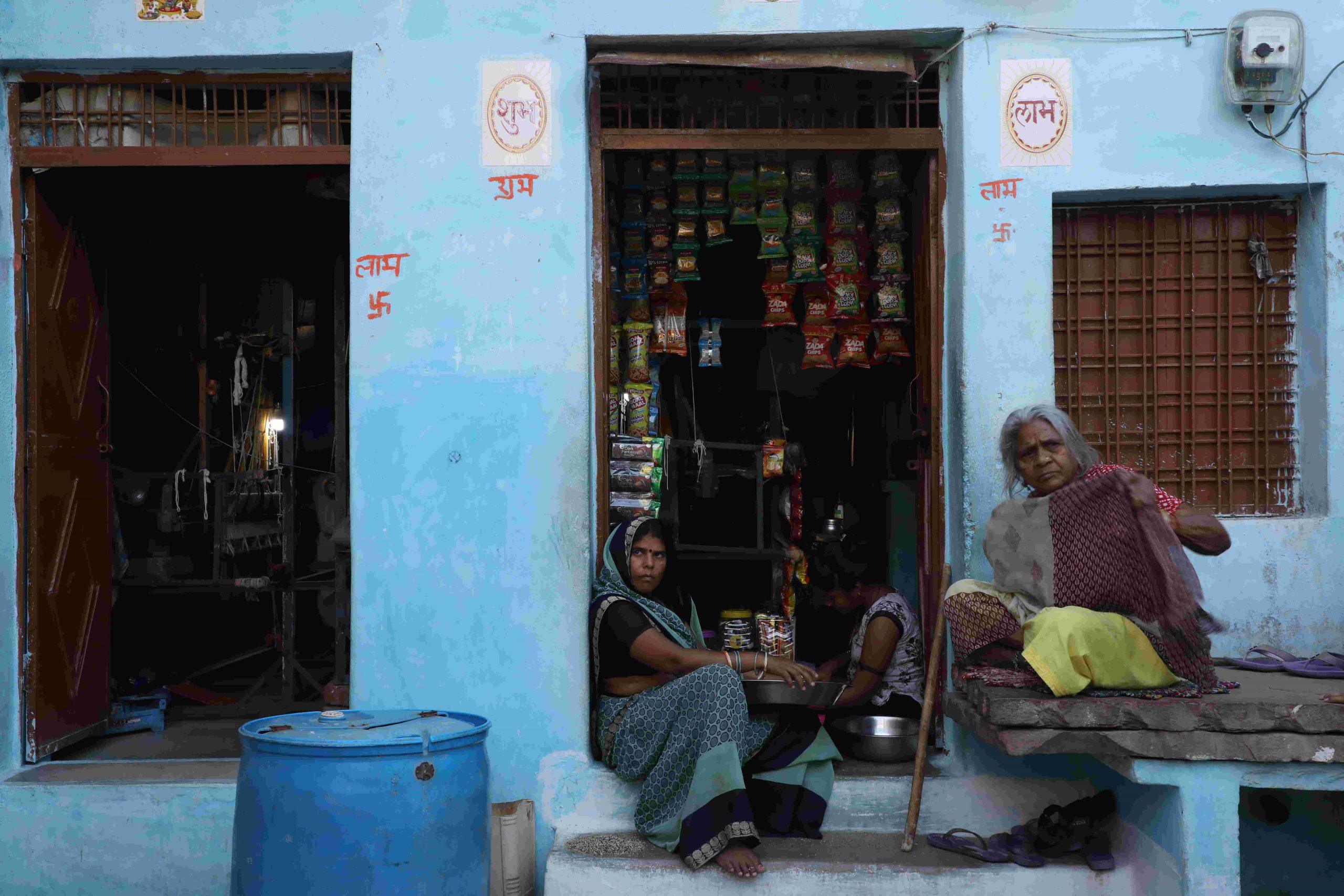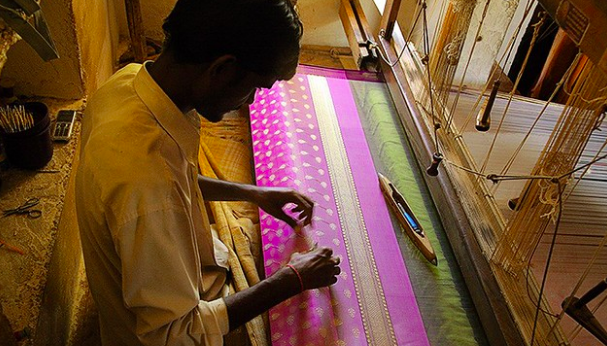An eerie silence prevails in Chanderi. The khat-khat sound of handlooms is a rarity now
Chanderi sarees are in great demand in India and abroad. But, the lockdown has affected the weavers and traders badly. More than 10,000 weavers are jobless and dust is gathering on 5,000 handlooms

Chanderi (Madhya Pradesh)
Bhawana Koli, who weaves the famous Chanderi sarees, has two handlooms. But these days, she is not weaving any sarees. Her handloom is demoted to its new status of a chip packets caddy, and the rest of her workroom looks more like a kirana shop piled with provisions. After sitting idle for two months, she has now remodelled her workroom to a general store in order to run her home.
She is not alone. In the last two months of the lockdown, like the handloom of Bhawna, around 5,000 handlooms have been closed in Chanderi town – situated around 200 kms from Madhya Pradesh’s capital Bhopal, and famous for its unique hand-crafted sarees. Those who have kept some stock of raw material earlier are still somehow managing; the rest of the weavers are sitting unemployed. An eerie silence prevails among houses and streets that used to resonate with the sound of khat-khat all day long.
“Our work has come to a standstill,” said Bhawna picking and cleaning grains outside her house. “There is no other work available here. Weavers also need to eat. We have two looms, which we used to operate as a husband-wife duo and earned Rs 400-500. We would weave a yard or a half saree throughout the day. But for the last three weeks, we didn’t earn a single penny and have to now borrow to eat,” she added.

In Bundelkhand, Chanderi is probably the only town with no perceptible migration to the cities. In Madhya Pradesh, sarees are woven in almost every household in this town situated by the Betwa river and surrounded by the hills and jungles. The Chanderi sarees of Bundelkhand are famous all over the world for the fine workmanship. The sarees are exported to many countries, including Dubai and the US. However, since the lockdown, both weavers and traders have been adversely affected.
“Chanderi only produces Chanderi sarees. Our problem is that due to the lockdown, the supply of raw materials, like silk, zari, etc, was hit. This led to the closure of around 5,000 looms. At least two weavers sit in every loom, so 10,000 people are directly unemployed,” said Vijay Koli, a trader, whose shop is opposite the police station in Chanderi.
Nearby, in a house, Munna Lal, 60, was fast at work, along with his two daughters and a son. They all were weaving with threads.
“Babuji, this is a jungla saree. This is the second saree that I am weaving in the last two months. People are sitting idle for as long as 15 days because we have nothing, no silk or zari, to work with. We have a family of eight people and three looms in our house. I used to manage all the expenses, including children’s education, with the help of this income. But now, everything is closed. I must have incurred a loss of at least Rs 25,000,” said Munna Lal, while showing the border of saree that he was weaving.
He elaborated: “My grandfather, great grandfather, and even his grandfather used to do the same work. You need to understand that Chanderi is in our blood. It is not that we earn a lot of money, my whole year’s average is Rs 200 a day, but then I get to earn it by working from my home, my town.”

As per the 2011 census, Chanderi has a population of 33,081. There are more than 6,000 handlooms here, with about 15,000 people working and earning their livelihood. The government has also opened a handloom park here to promote Chanderi, where group weaving is undertaken. The handloom park has 240 looms, but now all are closed.
Chanderi has two kinds of weavers and traders — the weavers who have only 2-3 handlooms, and the master weavers, who can be called mid-level entrepreneurs. They have 50 to 100 handlooms and they maintain with them a lot of stock of goods worth several lakhs. They used to weave sarees on demand, but the lockdown prolonged for so long that everybody is facing the crunch of raw materials.
Keshav, a weaver, said: “Chanderi sarees range from Rs 1,000 to Rs 50,000. The entire business is based upon the demand from the metro cities. Malls and markets are shut because of the lockdown. How do we work?”
Ravi Shankar Koli, a major Chanderi trader and the owner of Lemontree Company, said: “The sarees are woven in Chanderi, but all the raw material comes from outside. The silk coil comes from China, the zari comes from Surat, the baana, which weaves, comes from Coimbatore and Mumbai. The goods from China had stopped long ago. Now the problem is that in the absence of raw materials, the artisans don’t have work. The goods are not able to go out, so the traders do not have the money.”
According to Chanderi residents, the silk used for weaving used to be imported from Japan and Korea, but it wasn’t very strong. The country then switched to China, but China has not been able to supply goods properly for the past one year.
According to Koli, the business of Chanderi has been in trouble from 2019. The raw material rate has gone up by about one-and-half-times, so we were facing difficulty in selling the goods.

“The coronavirus hit China in January, but the production got affected long back. So, the silk, which was earlier costing Rs 3,500-3,600 a kg, has now gone up to Rs 5,600. Similarly, the prices of other goods have also increased; the sarees have become costlier and are difficult to sell. Our problems will not end even if China opens up. We won’t be able to manage unless the situation becomes normal in the whole country.”
The Chanderi sarees have been in tradition since the feudal times. The finesse with which the weavers of Chanderi weave these sarees, that body of work can’t be replicated by weavers in any corner of India.
Koli said: “Initially, our ancestors used to make headwears from yarn for the kings of Baroda. Later, at the behest of the queens, the yarn was made into sarees. Later on, silk was introduced. In the movie Pakiza, the song filmed upon Meena kumari ji — inhi logon ne le lina dupatta mora — in fact used a dupatta made here in Chanderi. In many films and serials, people appear wearing Chanderi. In 2011, Aamir Khan and Kareena Kapoor had visited a poor weaver in a village near Chanderi. That had benefitted us immensely.”
When Madhya Pradesh got its branding due to Chanderi, the Centre and the state government also took a number of steps for the betterment of weavers from Chanderi. A handloom park has been constructed at Chanderi at the cost of Rs 32 crore. A special pipeline of about Rs 8 crore has been laid from the Rajghat Dam to Chanderi to address the water problem of weavers.
SK Shakyawar, an officer from the Madhya Pradesh Handloom Corporation and who is associated with the handloom park project, said: “Things were fine before the lockdown. We were faring better than Banaras and Kanjivaram. Around 3,600 families were directly benefitted. After things improved, migration had stopped completely.”

The handloom park project was passed in the year 2008 by the central government, but the work began in 2017. The NTPC, in collaboration with the then MP Jyotiraditya Scindia, completed the park by paying huge sums of money for weavers under the company’s social responsibility.
Koli said: “Nearly 10 years back, our business had got affected. Even then Maharaj (Jyotiraditya Scindia) had helped. During that time, many weavers had left work and went to Ahmedabad, Indore and other cities. Now, if the government does not help, the situation would be the same again.”
Chanderi sarees are said to be fine enough to make even a sesame seed easily visible. Secondly, the threads are so well woven with one another that their loose ends are almost impossible to detect once a saree is ready.
Not only Chanderi, but the weavers all over the country are facing a crisis. Koli said: “Just two days ago, I spoke to some people in Kanjivaram who make their sarees with real zari. They have 1,500 handlooms, but the whole work there is closed for two months. Many people have told us to stop the entire production because they say there is no scope until September-October. People will first recover their losses incurred due to the lockdown, and only then would they spend on sarees.”
He added: “The government has announced two financial packages, but we have not received any help. The government should announce long-term schemes which would help people like us and our families.”
When Gaon Connection was about to leave Chanderi, we met Shahid, a weaver. He said: “We have already spent the money that we had. In fact, I have borrowed Rs 10-12,000. If this situation prevails any longer, we may have to either leave weaving or the Chanderi town.”

